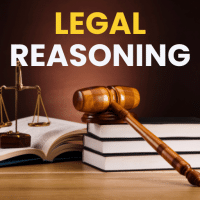CLAT Exam > CLAT Questions > What significant change does the Assam Compul...
Start Learning for Free
What significant change does the Assam Compulsory Registration of Muslim Marriages and Divorces Bill, 2024, introduce regarding age requirements for marriage?
- a)No age limit for marriage
- b)The woman must be at least 18 years old, and the man must be at least 21 years old
- c)Both partners must be over 25 years old
- d)The age limit is determined by local customs
Correct answer is option 'B'. Can you explain this answer?
Verified Answer
What significant change does the Assam Compulsory Registration of Musl...
The new law stipulates that for a marriage to be legally registered, the woman must be at least 18 years old and the man must be at least 21 years old. This change aims to prevent child marriages, which were previously allowed under the outdated 1935 law. By establishing a minimum age, the law seeks to protect vulnerable individuals and promote informed consent in marriages.
Most Upvoted Answer
What significant change does the Assam Compulsory Registration of Musl...
Significance of the Assam Compulsory Registration of Muslim Marriages and Divorces Bill, 2024
The Assam Compulsory Registration of Muslim Marriages and Divorces Bill, 2024, introduces critical age requirements for marriage, notably aimed at protecting the rights of women and ensuring responsible marital practices within the Muslim community.
Key Age Requirements
- The legislation mandates that:
- The woman must be at least 18 years old
- The man must be at least 21 years old
Implications of the Age Requirements
- **Protection of Minors**: By setting these age limits, the bill aims to protect young women and men from early and potentially exploitative marriages.
- **Empowerment of Women**: Requiring women to be at least 18 years old emphasizes their maturity and ability to make informed decisions regarding marriage.
- **Legal Framework**: This legislation establishes a formal requirement for age verification, which can help in reducing instances of child marriage within the community.
Comparison with Other Options
- **Option A (No age limit)**: This would not provide any protection against child marriages.
- **Option C (Both partners must be over 25 years old)**: This could be unrealistic and impractical for many individuals seeking to marry.
- **Option D (Local customs)**: Relying solely on local customs may perpetuate harmful practices and does not ensure a uniform standard for marriage age.
In summary, the Assam Compulsory Registration of Muslim Marriages and Divorces Bill, 2024, establishes clear age requirements that prioritize the safety and rights of individuals entering into marriage, thereby fostering a more equitable and responsible approach to marital practices.
The Assam Compulsory Registration of Muslim Marriages and Divorces Bill, 2024, introduces critical age requirements for marriage, notably aimed at protecting the rights of women and ensuring responsible marital practices within the Muslim community.
Key Age Requirements
- The legislation mandates that:
- The woman must be at least 18 years old
- The man must be at least 21 years old
Implications of the Age Requirements
- **Protection of Minors**: By setting these age limits, the bill aims to protect young women and men from early and potentially exploitative marriages.
- **Empowerment of Women**: Requiring women to be at least 18 years old emphasizes their maturity and ability to make informed decisions regarding marriage.
- **Legal Framework**: This legislation establishes a formal requirement for age verification, which can help in reducing instances of child marriage within the community.
Comparison with Other Options
- **Option A (No age limit)**: This would not provide any protection against child marriages.
- **Option C (Both partners must be over 25 years old)**: This could be unrealistic and impractical for many individuals seeking to marry.
- **Option D (Local customs)**: Relying solely on local customs may perpetuate harmful practices and does not ensure a uniform standard for marriage age.
In summary, the Assam Compulsory Registration of Muslim Marriages and Divorces Bill, 2024, establishes clear age requirements that prioritize the safety and rights of individuals entering into marriage, thereby fostering a more equitable and responsible approach to marital practices.

|
Explore Courses for CLAT exam
|

|
Question Description
What significant change does the Assam Compulsory Registration of Muslim Marriages and Divorces Bill, 2024, introduce regarding age requirements for marriage?a) No age limit for marriageb) The woman must be at least 18 years old, and the man must be at least 21 years oldc) Both partners must be over 25 years oldd) The age limit is determined by local customsCorrect answer is option 'B'. Can you explain this answer? for CLAT 2025 is part of CLAT preparation. The Question and answers have been prepared according to the CLAT exam syllabus. Information about What significant change does the Assam Compulsory Registration of Muslim Marriages and Divorces Bill, 2024, introduce regarding age requirements for marriage?a) No age limit for marriageb) The woman must be at least 18 years old, and the man must be at least 21 years oldc) Both partners must be over 25 years oldd) The age limit is determined by local customsCorrect answer is option 'B'. Can you explain this answer? covers all topics & solutions for CLAT 2025 Exam. Find important definitions, questions, meanings, examples, exercises and tests below for What significant change does the Assam Compulsory Registration of Muslim Marriages and Divorces Bill, 2024, introduce regarding age requirements for marriage?a) No age limit for marriageb) The woman must be at least 18 years old, and the man must be at least 21 years oldc) Both partners must be over 25 years oldd) The age limit is determined by local customsCorrect answer is option 'B'. Can you explain this answer?.
What significant change does the Assam Compulsory Registration of Muslim Marriages and Divorces Bill, 2024, introduce regarding age requirements for marriage?a) No age limit for marriageb) The woman must be at least 18 years old, and the man must be at least 21 years oldc) Both partners must be over 25 years oldd) The age limit is determined by local customsCorrect answer is option 'B'. Can you explain this answer? for CLAT 2025 is part of CLAT preparation. The Question and answers have been prepared according to the CLAT exam syllabus. Information about What significant change does the Assam Compulsory Registration of Muslim Marriages and Divorces Bill, 2024, introduce regarding age requirements for marriage?a) No age limit for marriageb) The woman must be at least 18 years old, and the man must be at least 21 years oldc) Both partners must be over 25 years oldd) The age limit is determined by local customsCorrect answer is option 'B'. Can you explain this answer? covers all topics & solutions for CLAT 2025 Exam. Find important definitions, questions, meanings, examples, exercises and tests below for What significant change does the Assam Compulsory Registration of Muslim Marriages and Divorces Bill, 2024, introduce regarding age requirements for marriage?a) No age limit for marriageb) The woman must be at least 18 years old, and the man must be at least 21 years oldc) Both partners must be over 25 years oldd) The age limit is determined by local customsCorrect answer is option 'B'. Can you explain this answer?.
Solutions for What significant change does the Assam Compulsory Registration of Muslim Marriages and Divorces Bill, 2024, introduce regarding age requirements for marriage?a) No age limit for marriageb) The woman must be at least 18 years old, and the man must be at least 21 years oldc) Both partners must be over 25 years oldd) The age limit is determined by local customsCorrect answer is option 'B'. Can you explain this answer? in English & in Hindi are available as part of our courses for CLAT.
Download more important topics, notes, lectures and mock test series for CLAT Exam by signing up for free.
Here you can find the meaning of What significant change does the Assam Compulsory Registration of Muslim Marriages and Divorces Bill, 2024, introduce regarding age requirements for marriage?a) No age limit for marriageb) The woman must be at least 18 years old, and the man must be at least 21 years oldc) Both partners must be over 25 years oldd) The age limit is determined by local customsCorrect answer is option 'B'. Can you explain this answer? defined & explained in the simplest way possible. Besides giving the explanation of
What significant change does the Assam Compulsory Registration of Muslim Marriages and Divorces Bill, 2024, introduce regarding age requirements for marriage?a) No age limit for marriageb) The woman must be at least 18 years old, and the man must be at least 21 years oldc) Both partners must be over 25 years oldd) The age limit is determined by local customsCorrect answer is option 'B'. Can you explain this answer?, a detailed solution for What significant change does the Assam Compulsory Registration of Muslim Marriages and Divorces Bill, 2024, introduce regarding age requirements for marriage?a) No age limit for marriageb) The woman must be at least 18 years old, and the man must be at least 21 years oldc) Both partners must be over 25 years oldd) The age limit is determined by local customsCorrect answer is option 'B'. Can you explain this answer? has been provided alongside types of What significant change does the Assam Compulsory Registration of Muslim Marriages and Divorces Bill, 2024, introduce regarding age requirements for marriage?a) No age limit for marriageb) The woman must be at least 18 years old, and the man must be at least 21 years oldc) Both partners must be over 25 years oldd) The age limit is determined by local customsCorrect answer is option 'B'. Can you explain this answer? theory, EduRev gives you an
ample number of questions to practice What significant change does the Assam Compulsory Registration of Muslim Marriages and Divorces Bill, 2024, introduce regarding age requirements for marriage?a) No age limit for marriageb) The woman must be at least 18 years old, and the man must be at least 21 years oldc) Both partners must be over 25 years oldd) The age limit is determined by local customsCorrect answer is option 'B'. Can you explain this answer? tests, examples and also practice CLAT tests.

|
Explore Courses for CLAT exam
|

|
Signup for Free!
Signup to see your scores go up within 7 days! Learn & Practice with 1000+ FREE Notes, Videos & Tests.


















